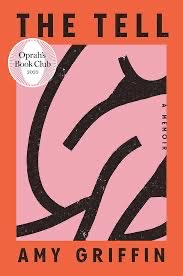What trauma hides, safety reveals. This story shows us how.

The Tell by Amy Griffin
The Tell and the Wonder of Memory
What struck me most about The Tell was the wonder of memory.
Our minds hold a treasure trove—not just of personal experiences, but of inherited ones too, passed down through our nervous systems. Most of the time, we move through life with only the essentials surfacing—just enough to function and cope.
But if we’re curious, we can open the vault.
We carry stories that live beneath the surface, shaping our world without ever rising to awareness. We sense them viscerally. We know they’re there, but we may not yet have the words or the images.
If we choose to follow the breadcrumbs—through free association, journaling, dreams, meditation, or psychedelic medicine—we open a door.
And we catch a glimpse of an inner universe: rich, layered, and alive with meaning.
But What If We Don’t Want to Know?
What if those stories are terrible? Do we still want to know them?
Someone once asked me, “Why would you dig all that stuff up? It’s over. It’s in the past.”
At the time, I was deep in my own personal exploration (and honestly, I always will be). Their question stayed with me.
It can be terrifying to imagine what lies beneath the visible tip of the memory iceberg.
What kind of abyss might be hidden beneath that glacier?
To them, I responded: “I can’t imagine not knowing. It’s there whether I remember it or not. It seems far less scary to see it—to understand it—than to live unknowingly shaped by it.”
We Need Good Maps and Guides
That’s not to say we should burst into the vault without care.
These are tender, often uncharted places. We need good maps. Skilled guides. A deep respect for the nervous system’s protective brilliance.
But there’s wonder, too.
A kind of reverence for the way memories return—not all at once, and not always when we want them to, but when we’re ready to work with them.
Why This Book Felt Personal
This theme landed close to home.
I’m one of the one in four girls who are sexually violated.
For me, it happened around the age of six.
I didn’t remember it until I was twenty-one—working in group homes with adolescent male sexual offenders.
Strangely, I was drawn to that population. Likely, a part of me was seeking resolution.
And once I remembered—once I had images, a timeframe, a narrative I could put words to—so many other things fell into place.
A Quick Note on the Structure
The first third didn’t immediately pull me in. I found myself wondering, Why are we talking about her running habits? Her grandparents? Her pressure to be “good”?
But trust me—push through (or skim).
Once it takes off, it’s powerful and deeply affecting.
💌 P.S. I write about memory, trauma healing, and nervous system safety in my biweekly newsletter, Remember & Reclaim. If this resonates, you can join here.
Chaos, Healing, and the Sleeping Conductor
If you’ve ever been in a psychedelic healing session—or supported someone who has—you might already know the metaphor I’m about to share. I first heard it from psychologist Hillary McBride:
“Psychedelics create a moment of chaos in the brain. The conductor of the orchestra—your cerebral cortex—goes to sleep. But the music keeps playing. Without the usual structure, new patterns emerge. New harmonies. Sometimes, long-forgotten melodies.”
That’s what happens to the protagonist in The Tell.
Her memories aren’t gone. They’re just… buried. Dormant. Waiting for conditions that say:
🌿 You’re safe now. You can remember.
This is where the neuroscience comes in—and why this book felt so accurate, so aligned with what I see in the therapy room.
A Quick Neuroscience Refresher: Why We Don’t Remember Until We Do
Memory retrieval isn’t like opening a file drawer. It’s more like a dance between three steps:
- Encoding (taking in the information)
- Consolidation (stabilizing it—often during sleep)
- Retrieval (accessing it later)
But here’s the thing:
Stress—especially trauma—interrupts encoding.
When your HPA axis is activated (fight-flight-freeze), your brain prioritizes survival over storage. That’s why many trauma survivors say, “I know something happened, but I can’t remember the details.”
The memory might still be there—just stored in fragments, or inaccessible without the right combination of safety, body-based awareness, and sometimes, altered states.
The Tell captures this with astonishing clarity.
Five Lessons I’m Bringing Into the Therapy Room from The Tell
Psychedelics Aren’t About Escaping—They’re About Returning
The Tell doesn’t romanticize the psychedelic journey. It shows it for what it often is: disorienting, messy, nonlinear. But also—when held with care—profoundly integrating.
The main character’s insights don’t arrive in a neat arc. They emerge in fragments.
Somatic memories.
Fleeting images.
Emotion first, language later.
And that’s what healing often looks like.
In therapy, we often talk about the window of tolerance—that sweet spot where we can stay present with what’s hard without becoming overwhelmed. But as one of my mentors, Hillary McBride, so wisely shared: sometimes, to truly heal trauma, we have to be taken outside that window. Because that’s where the trauma happened.
The difference is this:
In the past, we were alone.
Now, we’re accompanied.
In psychedelic-assisted therapy, this can mean revisiting overwhelming sensations, imagery, or feelings—but this time with a guide, a witness, a regulating presence. The nervous system is given a new experience: You can go there and not fall apart.
Through that accompaniment, we return to what is true.
-
Memory Is State-Dependent
One scene shows how a buried truth surfaces—not through logic, but through sensation.
The smell of jasmine. The weight of a blanket. A certain muscle contraction.
As a therapist, I’ve seen this again and again.
We don’t retrieve memories because we “try hard.”
We retrieve them because we feel safe—safe enough for the nervous system to loosen its grip. -
It’s Not Just What You Remember. It’s What You Do With It
The book doesn’t stop at revelation. It shows what happens next.
The grief. The disorientation. The renegotiation of identity.
Integration takes time, relationships, and deep nervous system tending. -
There’s Wisdom in the Body’s Delay
We might wonder why we don’t remember sooner, but there’s wisdom in that delay. The timing was the safety.
As a therapist, I often say: “You didn’t forget. Your body protected you.” -
Healing Is Nonlinear
There’s no tidy bow here.
But there’s reclamation.
What was fragmented can be re-membered—put back together with care.
Some of My Favorite Quotes from The Tell
“What if the forgetting was the most intelligent thing I ever did?”
“I wanted so badly to remember. But now that I do… I don’t know what to do with the knowing.”
“The medicine didn’t give me new memories. It just turned the lights back on.”
Final Thoughts:
l and the Radical Hope of Remembering
This book is for anyone who:
Has felt the ache of something just beyond awareness…
Knows there’s more to the story than what they can name…
Walking the sacred, messy path of reclaiming wholeness—
💌 Want more reflections like this?
I send out short, heartfelt letters every two weeks in my Remember & Reclaim newsletter—tools, metaphors, and nervous-system wisdom for the healing path.
Join here




